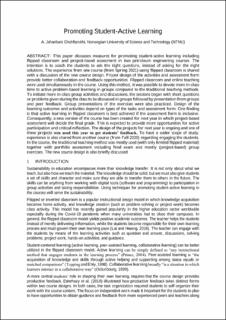| dc.contributor.author | Jahanbani Ghahfarokhi, Ashkan | |
| dc.date.accessioned | 2022-03-01T10:17:05Z | |
| dc.date.available | 2022-03-01T10:17:05Z | |
| dc.date.created | 2021-12-10T09:52:19Z | |
| dc.date.issued | 2021 | |
| dc.identifier.issn | 2535-4108 | |
| dc.identifier.uri | https://hdl.handle.net/11250/2982013 | |
| dc.description.abstract | This paper discusses measures for promoting student-active learning including flipped classroom and project-based assessment in two petroleum engineering courses. The intention is to coach the students to ask the right questions, instead of asking for the right solutions. The experience from one course (from Spring 2021) using flipped classroom is shared with a discussion of the new course design. Proper design of the activities and assessment form provide better collaboration and feedback opportunities. Flipped classroom and online teaching were used simultaneously in the course. Using this method, it was possible to devote more in-class time to active problem-based learning in groups compared to the traditional teaching methods. To initiate more in-class group activities and discussions, the sessions began with short questions or problems given during the class to be discussed in groups followed by presentation from groups and peer feedback. Group presentations of the exercises were also practiced. Design of the learning outcomes and activities depend on types of the tasks and assessment form. One finding is that active learning in flipped classroom is best achieved if the assessment form is inclusive. Consequently, a new version of the course has been created for next year in which project-based assessment will decide the final grade. This is expected to provide more opportunities for active participation and critical reflection. The design of the projects for next year is ongoing and one of these projects was used this year to get students’ feedback. To have a wider scope of study, experience is also shared from another course (from Fall 2020) regarding engaging the students. In the course, the traditional teaching method was mostly used (with only limited flipped material) together with portfolio assessment including final exam and mostly (project-based) group exercises. The new course design is also briefly discussed. | en_US |
| dc.language.iso | eng | en_US |
| dc.publisher | NTNU | en_US |
| dc.rights | Attribution-NonCommercial-NoDerivatives 4.0 Internasjonal | * |
| dc.rights.uri | http://creativecommons.org/licenses/by-nc-nd/4.0/deed.no | * |
| dc.title | Promoting Student-Active Learning | en_US |
| dc.type | Journal article | en_US |
| dc.description.version | publishedVersion | en_US |
| dc.source.volume | 7 | en_US |
| dc.source.journal | Læring om læring | en_US |
| dc.source.issue | 2 | en_US |
| dc.identifier.cristin | 1966928 | |
| cristin.ispublished | true | |
| cristin.fulltext | original | |

